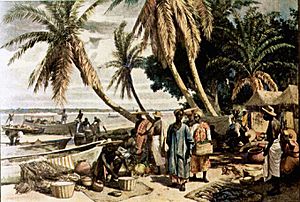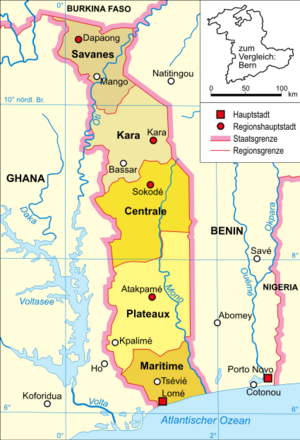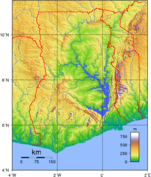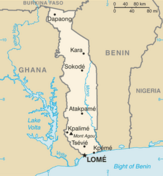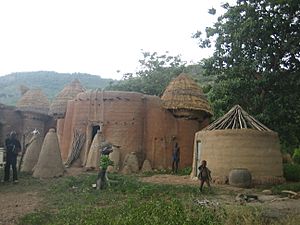Togo facts for kids
Quick facts for kids
Togolese Republic
République togolaise (French)
|
|
|---|---|
|
|
|
|
Motto: "Travail, Liberté, Patrie"
(English: "Work, Liberty, Homeland") |
|
|
Anthem: "Terre de nos aïeux"
|
|
| Capital and largest city
|
Lomé 6°8′N 1°13′E / 6.133°N 1.217°E |
| Official languages | French |
| Spoken languages | |
| Ethnic groups |
African (94.4%)
Aja, Ewe and Mina (42.4%)
Kabye and Tem (25.9%) Akan and Gurma (17.1%) Kposo and Akebu (4.1%) Ana-Ife (3.2%) Other West African groups (1.7%) |
| Religion
(2020)
|
|
| Demonym(s) | Togolese |
| Government | Unitary parliamentary republic under an authoritarian hereditary dictatorship |
| Jean-Lucien Savi de Tové | |
| Faure Gnassingbé | |
| Legislature | Parliament |
| Senate | |
| National Assembly | |
| Independence from Germany and France | |
|
• German Togoland
|
5 July 1884 |
| 6–26 August 1914 | |
|
• French Togoland partitioned
|
27 December 1916 |
|
• Autonomy within the French Union
|
24 August 1956 |
|
• Independence granted from France
|
27 April 1960 |
| Area | |
|
• Total
|
56,785 km2 (21,925 sq mi) (123rd) |
|
• Water (%)
|
4.2 |
| Population | |
|
• 2024 estimate
|
|
|
• 2022 census
|
8,095,498 |
|
• Density
|
125.9/km2 (326.1/sq mi) (60th) |
| GDP (PPP) | 2023 estimate |
|
• Total
|
|
|
• Per capita
|
|
| GDP (nominal) | 2023 estimate |
|
• Total
|
|
|
• Per capita
|
$1,004 (170th) |
| Gini (2015) | ▼ 43.1 medium |
| HDI (2022) | low · 163rd |
| Currency | West African CFA franc (XOF) |
| Time zone | UTC (GMT) |
| Date format | dd/mm/yyyy |
| Driving side | right |
| Calling code | +228 |
| ISO 3166 code | TG |
| Internet TLD | .tg |
|
|
Togo is a small country in West Africa. It shares borders with Ghana to the west, Benin to the east, and Burkina Faso to the north. The capital city, Lomé, is located along the Gulf of Guinea coast. In 2024, about 9.5 million people live here. French is the official language.
Long ago, Togo was a major center for the Atlantic slave trade. This period was known as the "Slave Coast." Many people from Togo now have descendants living in the Americas. Togo is also known for its unique culture, including Voodoo practices. The country has many different plants and animals, like monkeys, snakes, and lizards.
Contents
Togo's History
Early History and Slave Trade
Archaeological finds show that early tribes in Togo could make pottery and work with iron. The name "Togo" comes from the Ewe language and means "behind the river." Between the 11th and 16th centuries, different tribes moved into the area. These included the Ewé from the west and the Mina and Gun from the east. Most of them settled near the coast.
The Atlantic slave trade began in the 16th century. For the next 200 years, the coastal area was a busy trading center for Europeans looking for slaves. This sad history gave Togo and the surrounding region the name "The Slave Coast."
German Rule and World War I
In 1884, a special paper was signed in Togoville with King Mlapa III. This agreement allowed Germany to claim a protected area along the coast. Germany slowly expanded its control further inland. The borders were set after German forces took over the inner lands and signed agreements with France and Britain. In 1905, this area became the German colony called Togoland.
During this time, local people were forced to work. They had to grow crops like cotton, coffee, and cocoa, and pay taxes. A railway and the port of Lomé were built to help export these farm products. The Germans also brought new ways of growing cocoa, coffee, and cotton, and improved the country's buildings and roads.
When World War I started, British and French forces invaded Togoland. This was part of the Togoland Campaign. German forces were defeated, and the colony surrendered on August 26, 1914. Later, in 1916, Togoland was divided into two parts: British Togoland and French Togoland. In 1922, the League of Nations gave Britain and France permission to govern these parts.
Path to Independence
After World War II, these areas became United Nations Trust Territories. In 1956, the people of British Togoland voted to join the Gold Coast. This area later became the independent nation of Ghana in 1957.
French Togoland became a self-governing republic within the French Union in 1959. However, France still controlled its defense, foreign relations, and money matters.
Independence and Modern Togo
Togo officially became an independent country, the Togolese Republic, on April 27, 1960. In the first presidential elections in 1961, Sylvanus Olympio became the first president. He won with 100% of the votes, as the opposition parties did not participate. A new constitution was adopted on April 9, 1961, setting up the National Assembly of Togo as the main law-making body.
Togo made history at the 2008 Summer Olympics in Beijing. Benjamin Boukpeti won a bronze medal in canoeing, which was the first Olympic medal for an African nation in this sport.
In June 2022, Togo joined the Commonwealth of Nations, a group of countries that were mostly part of the British Empire.
Regions and Cities
Togo is divided into five main areas called regions. These regions are then split into 39 smaller areas called prefectures. From north to south, the regions are Savanes, Kara, Centrale, Plateaux, and Maritime.
Most of Togo's population, about 65%, lives in small villages. These villages are often focused on farming or raising animals. The capital city, Lomé, has grown a lot over the years. In 2010, the Lomé area had over 1.4 million residents.
- Lomé: The capital and largest city.
- Sokodé: An important city in the central region.
- Kara: A major city in the northern part of Togo.
- Kpalimé: Known for its beautiful scenery and crafts.
- Atakpamé: A city located in the Plateaux Region.
- Dapaong: The largest city in the northern Savanes Region.
- Tsévié: Another significant city in the Maritime Region.
Togo's Geography
Togo covers an area of about 56,785 square kilometers (21,925 square miles). It has a coastline of 56 kilometers (35 miles) along the Bight of Benin in the south. To its west is Ghana, to its east is Benin, and to its north is Burkina Faso. Togo is located just north of the equator.
The coast of Togo has sandy beaches and lagoons. In the north, the land is mostly rolling savanna plains. The center of the country has hills. The southern part of Togo features a mix of savanna and woodlands. This area leads to a coastal plain with lagoons and marshes. The highest point in Togo is Mont Agou, which is 986 meters (3,235 feet) tall. The longest river is the Mono River, flowing 400 kilometers (250 miles) from north to south.
Climate and Nature
Togo has a "generally tropical" climate. Average temperatures range from about 23°C (73°F) on the coast to 30°C (86°F) in the northern areas. The north has a drier climate, typical of a tropical savanna.
Togo is home to different natural areas. These include forests near the coast and savannas further inland. The coastal areas also have marshes and mangroves.
To protect its nature, Togo has established at least five parks and reserves. These include Abdoulaye Faunal Reserve, Fazao Malfakassa National Park, and Kéran National Park. These places help protect the country's diverse plants and animals.
Togo's Economy
The economy of Togo mainly relies on agriculture. Farming provides jobs for about 65% of the people who work. Important farm products include coffee, cocoa, cotton, yams, cassava (also known as tapioca), corn, beans, rice, millet, and sorghum.
Besides farming, Togo also has some industries. These include phosphate mining, processing farm products, making cement, handicrafts, and textiles. Togo is known to have the fourth-largest phosphate deposits in the world.
Togo is considered one of the least developed countries. It serves as an important center for trade in its region. The country imports items like machinery, equipment, petroleum products, and food. Its main exports are cocoa, coffee, phosphates, and cotton.
The government has been working to improve the economy. This includes making trade and port activities more open. However, some plans, like selling off government-owned cotton, telecommunications, and water companies, have faced delays.
Government in Togo


The president of Togo is chosen by the people in elections every five years. The president is the leader of the armed forces. They also have the power to suggest new laws and to dissolve the parliament.
The president and the government hold the main power to run the country. The head of the government is the Prime Minister, who is chosen by the president.
People and Languages
| Population | |||
|---|---|---|---|
| Year | Million | ||
| 1950 | 1.4 | ||
| 2000 | 5.0 | ||
| 2018 | 7.9 | ||
In 2022, Togo's population was about 8.6 million people. This is a big increase from 1981, when the population was around 2.7 million. The capital city, Lomé, has also grown a lot.
Togo has many different ethnic groups. The largest ones are the Ewe, Mina, Tem, Tchamba, and Kabre. Many people in Togo follow traditional African beliefs. Others are Christian or Muslim.
Languages Spoken in Togo
Togo is a country with many languages. There are 39 different languages spoken here. The only official language is French. This means French is used in schools, government, media, and business.
Two local languages are also very important and are called national languages. These are Ewé and Kabiyé. Even though French is the official language, these local languages are widely spoken by many communities across the country.
Culture in Togo
Togo's culture is a mix of influences from its many ethnic groups. The largest groups, like the Ewe, Mina, Tem, Tchamba, and Kabre, all add to the country's rich traditions. Some people still follow old animistic practices and beliefs.
The Ewe people are known for their statuettes. These small statues are often used in the worship of the ibeji, which are twin spirits. Unlike some other African cultures, Ewe art often features sculptures and hunting trophies instead of masks.
The town of Kloto is famous for its wood-carvers. They create unique "chains of marriage," where two figures are carved from a single piece of wood and linked by rings. Kloto is also known for its dyed fabric batiks. These fabrics show colorful scenes from daily life long ago.
The weavers of Assahoun create special loincloths used in ceremonies. The artist Sokey Edorh creates paintings inspired by the dry, windy landscapes of Togo. Another artist, Paul Ahyi, used a technique called "zota," which is a type of pyroengraving. His large artworks can be seen in Lomé.
Sports and Media
Basketball is a very popular sport in Togo, second only to football. Togo also has a national team for beach volleyball.
Togo has various forms of media, including radio, television, and online news. The state-owned television service is called Togolese Television.
Religion in Togo
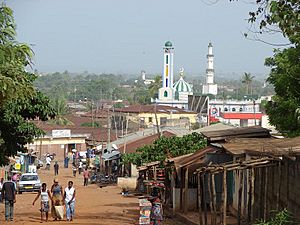
About 51% of the people in Togo follow local traditional beliefs. Around 29% are Christian, and 20% are Muslim.
Related pages
Images for kids
-
Women in Sokodé.
-
Footballer Emmanuel Adebayor.
See also
 In Spanish: Togo para niños
In Spanish: Togo para niños







